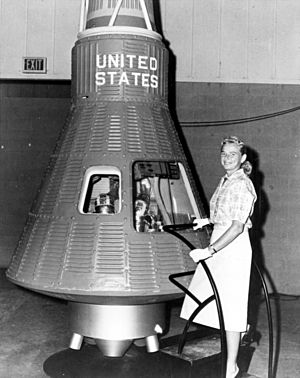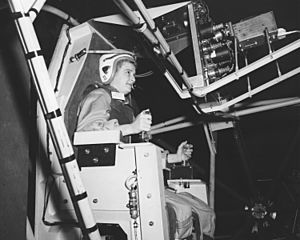Jerrie Cobb facts for kids
Quick facts for kids
Jerrie Cobb
|
|
|---|---|

Jerrie Cobb with a Project Mercury spacecraft
|
|
| Born | March 5, 1931 Norman, Oklahoma, US
|
| Died | March 18, 2019 (aged 88) Florida, US
|
| Education | Oklahoma City Classen High School |
| Known for | Part of the Mercury 13 |
| Aviation career | |
| First flight | 1943 |
Geraldyn M. Cobb (March 5, 1931 – March 18, 2019), known as Jerrie Cobb, was an American aviator. She was a brave pilot who loved to fly. Jerrie was also part of the Mercury 13. This was a group of women who took the same tests as the first male astronauts. Jerrie was the first woman to pass all of these tough tests.
Contents
Early Life and First Flights
Jerrie Cobb was born on March 5, 1931, in Norman, Oklahoma. Her father was a pilot, and he encouraged her love for flying. Jerrie first flew in an airplane when she was just twelve years old. It was her father's open-air cockpit biplane.
At 16, she was already flying around the Great Plains. She would drop leaflets over small towns to announce circuses. She often slept under her plane's wing to save money. She gave rides to people to earn money for fuel. By age 17, Jerrie earned her private pilot's license. A year later, she got her commercial pilot's license.
Amazing Aviation Career
Jerrie faced challenges because she was a woman in aviation. Many male pilots returned after World War II. This made it harder for women to find good flying jobs. So, Jerrie took on less popular jobs. She flew planes to patrol pipelines and even spray crops.
She kept learning and earned many different pilot licenses. By age 21, she was flying military fighter planes and large bombers. She delivered these planes to air forces all over the world.
Jerrie set three world aviation records in her 20s:
- In 1959, she set a world record for the longest nonstop flight in a light plane.
- Also in 1959, she set a world speed record for light planes.
- In 1960, she set a world altitude record for lightweight aircraft. She flew to 37,010 feet (about 11.3 kilometers)!
Jerrie was the first woman to fly in the Paris Air Show. This is the world's biggest air show. Other pilots called her "Pilot of the Year." She also won the Amelia Earhart Gold Medal of Achievement. Life Magazine named her one of the "100 most important young people in the United States."
By 1959, Jerrie was a pilot and manager for a company called Aero Design and Engineering. This made her one of the few women in charge in the aviation world. By 1960, she had flown for 7,000 hours!
Dreaming of Space: The Mercury 13

Jerrie Cobb wanted to go to space. She successfully completed all the tough physical and mental tests. These were the same tests used to choose the first seven male astronauts for NASA's Mercury program. However, this was not an official NASA program for women.
In 1962, Jerrie spoke to a group in Congress about women astronauts. Astronaut John Glenn said that "men go off and fight the wars and fly the airplanes." He thought women should not be in this field. Just a few months later, the Soviet Union sent the first woman into space, Valentina Tereshkova.
Jerrie and other women from the Mercury 13 group tried hard to train alongside the men. But NASA had strict rules. Astronauts had to be military test pilots with engineering skills. Since all military test pilots were men at that time, women were not allowed.
Later Life and Humanitarian Work
After her dream of space flight didn't happen, Jerrie started a new mission. For over 30 years, she did missionary work in South America. She flew planes to help people. She transported supplies to faraway tribes. She also found new air routes over the dangerous Andes Mountains and Amazon rainforest. She used her own maps to guide her over huge, unexplored areas.
Many governments honored Jerrie for her work. These included Brazil, Colombia, Ecuador, France, and Peru. In 1981, she was even nominated for the Nobel Peace Prize for her amazing humanitarian efforts.
In 1999, there was a campaign to send Jerrie to space. This was to study how aging affects the body in space. Astronaut John Glenn had flown to space at an older age for this reason. Jerrie, at 67, had passed the same tests as Glenn. She wanted to go to see if the effects were the same for women. But NASA said they had no plans for more older citizens in space. Many people felt this was a missed chance for NASA to correct a past mistake. Jerrie Cobb never reached her goal of flying in space.
Jerrie Cobb received many awards for her flying. She died on March 18, 2019, at her home in Florida. She was 88 years old.
Awards and Honors
- Amelia Earhart Gold Medal of Achievement
- Named Woman of the Year in Aviation
- Named Pilot of the Year by the National Pilots Association
- Fourth American to be awarded Gold Wings of the Fédération Aéronautique Internationale
- Honored by the government of Ecuador for finding new air routes over the Andes Mountains
- 1962 Received the Golden Plate Award of the American Academy of Achievement
- 1973 Awarded Harmon International Trophy for "The World's Best Woman Pilot" by President Richard Nixon
- Inducted into the Oklahoma Hall of Fame as "the Most Outstanding Aviatrix in the US"
- Received Pioneer Woman Award for her "courageous frontier spirit" flying in the Amazon rainforest
- 1979 Bishop Wright Air Industry Award for her "humanitarian contributions to modern aviation"
- 2000 Inducted into "Women in Aviation International Pioneer Hall of Fame"
- 2007 Honorary Doctor of Science degree from University of Wisconsin–Oshkosh
- 2012 Inducted into the National Aviation Hall of Fame

